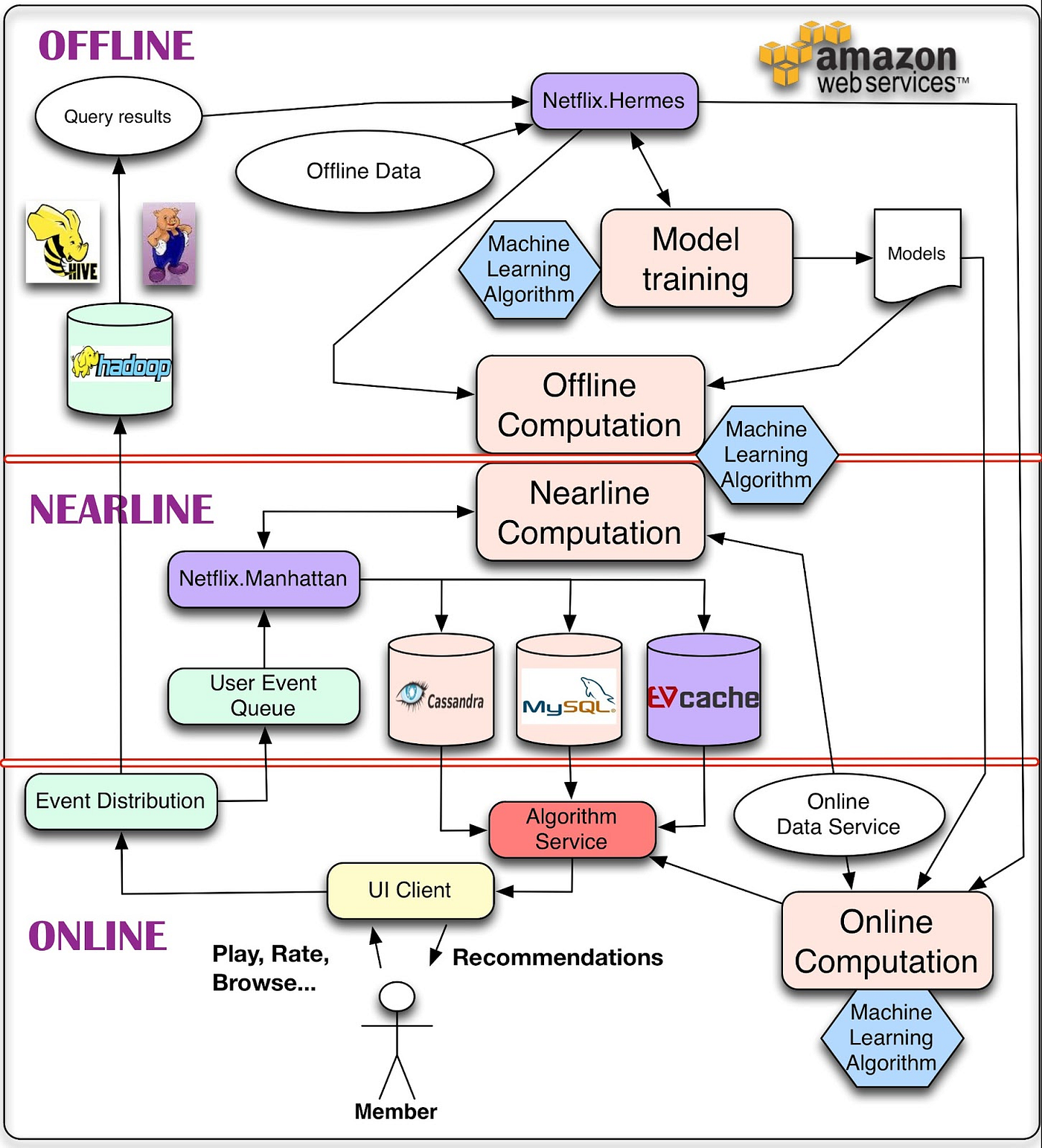Xinsong Li, Dec 2020
[Public Repo. Unfinished article]
This survey provided a comprehensive summary about the recommender system state-of-art knowledge.
Recommender Systems usually classified into 2 types by
- Content Based Filtering
- Collabrative Filtering
Depends on if the model is learned from underlying data, there are 2 types,
- Model Based
- Memory Based
-
Movie Recommendation i.e., Netflix
-
Music Recommendation i.e., Last.fm, Pandora Radio
-
Product Recommendation i.e., Amazon
-
News Recommendation i.e., Google News, Toutiao
-
People Recommendation i.e., LinkedIn
Collabrative Filtering is best suited to problem with known data on users, but lack of data for items or lack of feature extraction for items of interest. [6]
Collabrative Filtering approaches build a model from user's past behavior (items previously purchased or selectec/rated) as well as similar decision made by others. [10]
[30] [31] He et al. proposed a Neural Collbarative Filtering algorithm by replacing the inner product with a neural architecture that can learn an arbitrary function from data. NCF is generic and can express and generalize matrix factorization under its framework. To supercharge NCF modeling with non-linearities, they propose to leverage a multi-layer perceptron to learn the user-item interaction function.
-
Root Mean Square Error (RMSE) Measure of average error in predicted ratings
-
R Square (R^2) Essentially how much of the total variation is explained by the model
-
Mean Absolute Error (MAE)
-
Explained Variance - How much of the variance in the data is explained by the model
-
Precision The proportion of recommended items that are relevant
-
Recall Measures the proportion of relevant items that are recommended
-
Normalized Discounted Cumulative Gain (NDCG) Evaluates how well the predicted items for a user are ranked based on the relevance
-
Mean Average Precision (MAP) Average precision for each user normalized over all users
-
Area Under Curve (AUC) Integral area under the receiver operating characteristic curve
-
Logistic Loss (Logloss) The negative log-likelihood of the true labels given the prediction of a classifier
The number of items sold on majority e-commerce sites is extremely large. The most active users will only have rated a small subset of the overall database. Thus, even the most popular items have very few ratings. [10]
[1] http://ijcai13.org/files/tutorial_slides/td3.pdf
[2] Hulu
[3] Xavier Amatriain and Justin Basilico. System Architectures for Personalization and Recommendation (by Netflix Technology Blog)
[4] https://github.com/mandeep147/Amazon-Product-Recommender-System
[5] https://github.com/smwitkowski/Amazon-Recommender-System
[6] Recommendation Systems: A Review https://towardsdatascience.com/recommendation-systems-a-review-d4592b6caf4b
[7] Recommender system using Bayesian personalized ranking
[8] Introduction to Recommender Systems in 2019
[9] Introduction to recommender systems
[10] https://en.wikipedia.org/wiki/Recommender_system#Mobile_recommender_systems
[11] Book: 推荐系统实践 项亮
[12] Book: Recommender systems:An introduction, Dietmar Jannach / Markus Zanker / Alexander Felfernig / Gerhard Friedrich, 2013
[14] Robin Burke Recommender Systems: An Overview
[15] https://github.com/microsoft/recommenders
[16] https://github.com/kevinmcmahon/tagger
[17] https://github.com/timlyo/pyTag
[18] Hybrid Recommendation Approaches
[21] Trend or No Trend: A Novel Nonparametric Method for Classifying Time Series
[22] https://github.com/microsoft/recommenders/blob/master/examples/00_quick_start/als_movielens.ipynb
[23] https://github.com/microsoft/recommenders/tree/master/examples/03_evaluate
[24] Asela Gunawardana and Guy Shani: A Survey of Accuracy Evaluation Metrics of Recommendation Tasks
[25] Dimitris Paraschakis et al, "Comparative Evaluation of Top-N Recommenders in e-Commerce: An Industrial Perspective", IEEE ICMLA, 2015, Miami, FL, USA.
[26] Yehuda Koren and Robert Bell, "Advances in Collaborative Filtering", Recommender Systems Handbook, Springer, 2015. Chris Bishop, "Pattern Recognition and Machine Learning", Springer, 2006.
[27] Errico, James H., et al. “Collaborative recommendation system.” U.S. Patent №8,949,899. 3 Feb. 2015.
[28] Davidson, James, et al. “The YouTube video recommendation system.” Proceedings of the fourth ACM conference on Recommender systems. 2010.
[29] Adomavicius, Gediminas, and Alexander Tuzhilin. “Toward the next generation of recommender systems: A survey of the state-of-the-art and possible extensions.” IEEE transactions on knowledge and data engineering 17.6 (2005): 734–749.
[30] James Loy, [Deep Learning based Recommender Systems, A gentle introduction to modern movie recommenders](https://towardsdatascience.com/deep-learning-based-recommender-systems-3d120201db7e]
[31] Xiangnan He, Lizi Liao, Hanwang Zhang, Liqiang Nie, Xia Hu, Tat-Seng Chua. Neural Collaborative Filtering. arXiv:1708.05031. 2017
[32](https://towardsdatascience.com/introduction-to-recommender-systems-6c66cf15ada) Introduction to recommender systems, Overview of some major recommendation algorithms.
[33] Recommender Systems: From Filter Bubble to Serendipity
[34] REFORE: A recommender system for researchers based on bibliometrics
[35] News Recommendation Competition
